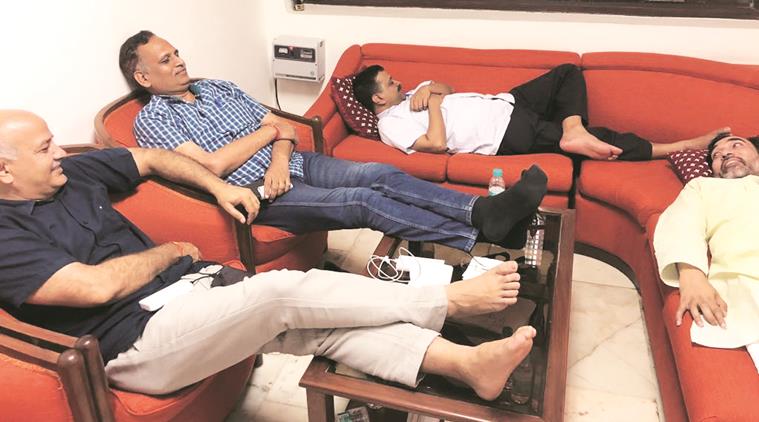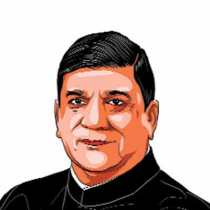A Petty Quarrel
LG-CM spat in Delhi inconveniences citizens, diminishes high offices

Delhi Chief Minister Arvind Kejriwal on dharna at the LG’s office. (File)
The unending Delhi saga of “full statehood” versus “partial statehood” has less to do with constitutional correctness and more to do with the political compulsions, instincts and pettiness. The dissonance over Delhi’s status dates back to the Sheila Dikshit era. Relations between the then chief minister and lieutenant general were tense even though the Congress held office at both the state and the Centre. It has not changed. The principle of special sensitivities for national capitals (for example, Washington DC, London, Paris etc.) on account of their national and international importance, geographical location and strategic significance has been consistently invoked to make a case for Delhi’s claim to “full statehood” to be treated differently from that for Goa, or even a more empowered “partial statehood” in Puducherry.
The result is a fractured arrangement of power-sharing, with law and order, land and services residing with the central government. This arrangement has always been contested by the state government. Such constitutional arrangements militate against the preferences of the “elected government”, which is accountable to the citizens. Political parties that endorse the “full statehood” demand in manifestos, however, fall silent on winning power at the Centre. The state government’s frustrations are understandable. The AAP formed the government after winning 67 of the 70 seats in the 2015 Delhi assembly elections. The formation of the government was followed by the LG’s office imposing more constraints like disabling the power of the state government to transfer employees, ordering vigilance probes on complaints or proceeding against corrupt officials.
These questionable restrictions also came in the backdrop of unprecedented theatrics. A perfectly legitimate grouse about the timing and the intent of these notifications was soon lost in the personalised, combative and anarchic retaliation from the party in power in the state. The expanding political ambitions of the AAP, which went beyond Delhi, may have also contributed to the widening of the Centre-state divide. The Centre successfully and, perhaps unfairly, checkmated the state government. Meanwhile, the party running the state government took the battle to Varanasi and Punjab. The forays were unsuccessful, leaving the party even more frustrated. Even on the current issue of the “strike” by Delhi’s bureaucrats, the essential character of the protests has been theatrical and obstructionist. The IAS association has refuted the allegations (that the bureaucrats are hampering the work of the government) as “unwarranted and baseless”. The association points to the passing of the state budget and the accompanying budget session as proofs of a working machinery. The sense that bureaucrats have been “agitated” following the alleged attack on the Delhi chief secretary has sullied the environment.
Trust between the political class and bureaucracy is necessary for good governance. The impasse in Delhi suggests a total breakdown in the relations between the two sections. It also implies that the entire administrative staff is against the state government. This is not possible given the diversity and scale of the administrative machinery. The government must introspect and adopt a more mature approach to the bureaucracy. Slandering the entire administration as corrupt may rouse the cadres, but yields diminishing returns in the long term.
The state government is well within its moral right to demand the inclusion or exclusion of any official on basis of apolitical and professional considerations, as opposed to intemperate, whimsical and blanket aspersions cast on the entire “system”. The means and expressions of the current protest reflect reciprocal pettiness and diminution of constitutional sobriety. Unintentionally, the case for more empowerment of the Delhi state government — not “full statehood” — may have further stalled with the repeated optics of the “sleep-in” at the Raj Niwas waiting room: It is reminiscent of the AAP’s 2014 street protests outside Rail Bhawan. Delhi with its commitments to international confabulations, transit infrastructure, inter-intra dependence on neighbouring states and stately ceremonies cannot risk fanciful drama. This round of LG-CM spat has further diminished the nobility of constitutional offices, without achieving the desired corrections.
The writer, a retired lieutenant general of the Indian army, was lieutenant governor of Andaman and Nicobar Islands and Puducherry.
For all the latest Opinion News, download Indian Express App
More From Bhopinder Singh
- The Dignity of her OfficeKiran Bedi’s talent could be Puducherry’s gain, but she needs to tone her language ..
- Rough Waters AheadSouth China Sea verdict has changed the ground rules for future engagement with China...







































No hay comentarios:
Publicar un comentario